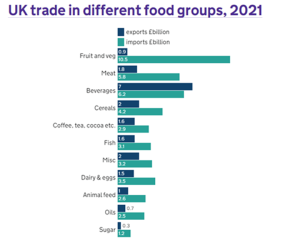12 Strategies to Manage Pricing Pressures
Food and Drink Businesses
The UK food and drink industry is one of the most valuable sectors to the UK economy; with 13.6% of employment in the UK in food, drink, agriculture, or farming and £1 trillion in annual sales across the sector.
However, the cost-of-living crisis and increasing prices are hitting the industry the hardest and food and drink inflation is currently at a 40 year high with no sign of slowing, causing some real problems for businesses in the industry.

7th June 2023
-
Laura Seaward See profile
Why does the food and drink industry face such significant impacts from rising prices?
Several factors make this sector particularly vulnerable to price pressures in the current economic climate.
Supply Chain Issues
Recent statistics from 2021 reveal that the UK imported £45.7 billion worth of food and drink products, while only exporting £20.4 billion worth of such items. This level of imports exposes the food, drink, and agriculture supply chains to unpredictable global forces beyond our control, such as weather events and geopolitical risks like conflicts. Global warming has led to extreme weather conditions, including floods and droughts, reducing the availability of certain produce. Additionally, the Ukraine conflict has disrupted worldwide supplies of grains and oils, causing shortages of key ingredients for many food and drink items. We are also witnessing the emergence of food nationalism, where some countries restrict exports of critical products to secure sufficient ingredients for themselves, impacting other nations that lack access due to resource or climate limitations. These factors contribute to reduced availability, increased competition, and escalating prices due to the basic principles of supply and demand.
Food statistics in your pocket – GOV.UK (www.gov.uk)

Labour Shortages
As mentioned earlier, 13.6% of employment in the UK lies within the food, drink, agriculture, or farming sector. However, Brexit has limited the movement of workers between the UK and the EU, resulting in fewer individuals seeking roles in this industry. The COVID-19 pandemic further exacerbated labour shortages, particularly in the hospitality segment. Lockdown measures and subsequent economic impacts led to furloughs and redundancies, prompting many employees to seek higher-paying positions with better work-life balance. Although the industry has experienced a swift recovery, the challenging nature of long and unsocial working hours, coupled with relatively lower wages, has made it difficult to attract former employees back to the sector.
Energy Price Volatility
Given the year-round freezing, chilling, and baking operations involved in the food and drink industry, energy consumption is substantial. Consequently, businesses in this sector are highly susceptible to energy price volatility. Currently, energy prices are at a record high, driven by increased demand during the post-pandemic recovery and the geopolitical tensions resulting from Russia’s invasion of Ukraine. These factors present additional challenges to our vulnerable food and drink industry.
Transportation
Transportation costs are also on the rise, and the significant volume of imports in the UK underscores the vulnerability of the industry to these increases. Stricter carbon emission reduction targets, higher fuel prices, and increased regulatory requirements due to Brexit and EU legislation have added extra costs to businesses in the sector. Goods imported are taking longer to reach the UK, further compounding the challenges.
The supply chain issues, and labour shortages outlined above simply mean that businesses must pay more to acquire key ingredients/produce they need or to bring in employees to keep their business going and in simple terms, goods imported are taking longer to reach the UK and cost more.
How can food and drink businesses cope with increasing prices?
It is crucial for businesses in the industry to focus on strengthening their operations, enhancing resilience, and ensuring future-proofing through profitability, cost reduction, or revenue growth.
At Old Mill, we understand the importance of exploring viable solutions to manage pricing pressures. Here are some recommendations to help you navigate these challenges and optimise your business:
1. Strengthen Supplier Relationships: Engage in meaningful conversations with your suppliers to foster mutually beneficial partnerships. Evaluate the potential to enhance collaboration, adding value to both parties. Explore possibilities for loyalty discounts or bulk purchasing advantages. If feasible, discuss shorter payment terms that could lead to discounts. Additionally, consider suggesting more cost-effective delivery options that can streamline the supply chain.
2. Assess Alternative Suppliers: Consider alternative suppliers who may offer more cost-effective solutions. However, ensure that any changes maintain the integrity of your products and brand. Thoroughly evaluate the credibility and reliability of potential suppliers before making any transitions.
3. Optimise Delivery Options: Review your delivery methods to identify cost-saving opportunities. Assess whether different couriers or delivery options could offer better pricing structures. You may also consider slower delivery options that can lead to cost savings without compromising customer satisfaction.
4. Pricing Strategies: Carefully evaluate your pricing structure to ensure it aligns with market trends and competitor positioning. Assess the feasibility of moderate price increases that won’t drive away existing customers. Avoid underselling your products and services; make sure you are appropriately compensated for the value you provide. Additionally, consider the possibility of making certain products more affordable or adding value through free extras or samples, which can boost sales and positively impact gross profit. But make sure you understand your margin by product to inform your decision making process.
5. Enhance Sustainability and Reduce Carbon Footprint: Capitalising on the growing demand for ethical and sustainable brands, focus on improving sustainability practices and reducing your carbon footprint. Consider initiatives like becoming a B-Corp, which involves comprehensive improvements across your business, attracting more environmentally conscious customers.
6. Source Local Ingredients: Where possible, explore sourcing ingredients locally. Not only does this contribute to a reduced carbon footprint, but it may also prove cost-effective, particularly in light of increasing transport costs and the volatility outlined earlier.
7. Packaging Considerations: Evaluate your packaging materials and explore eco-friendly alternatives such as paper or cardboard instead of plastic. This transition can not only save costs on packaging and transportation but also demonstrate your commitment to environmental stewardship.
8. Strategic Advertising: Conduct market research to identify opportunities for enhancing your brand’s appeal to customers. Consider revamping your branding to align with changing consumer preferences. Additionally, explore alternative advertising channels or target new industries to expand your customer base.
9. Prioritise Staff Welfare: Invest in your employees’ welfare and foster a positive work culture. Training and treating your team well can significantly reduce recruitment costs and increase loyalty, resulting in a more stable workforce.
10. Embrace Technological Efficiencies: Leverage technology to streamline operations and improve efficiency. Explore investments in equipment that can maximise production output. Consider implementing chatbots on your website to handle customer enquiries, allowing your staff to focus on core production activities.
11. Embrace Diversification: Embrace creative thinking and explore diversification opportunities when necessary. For example, if you run a distillery, consider introducing tours to generate additional revenue. Identify potential uses for any wastage and explore opportunities to repurpose or sell it.
12. Leverage Our Success Program: Engage with our success program, where our experts can assist you in understanding your financial figures and challenge you to identify areas for improvement. We offer comprehensive support to strengthen your financial performance and build business resilience.
By implementing these strategies and leveraging our expertise, you can proactively address pricing pressures and position your food and drink business for sustainable growth and success.
At Old Mill, we are honoured to be your trusted partner, and we look forward to serving you with passion, expertise, and a shared commitment to your financial future.
Want to know what we can do for you and your business? click here…

